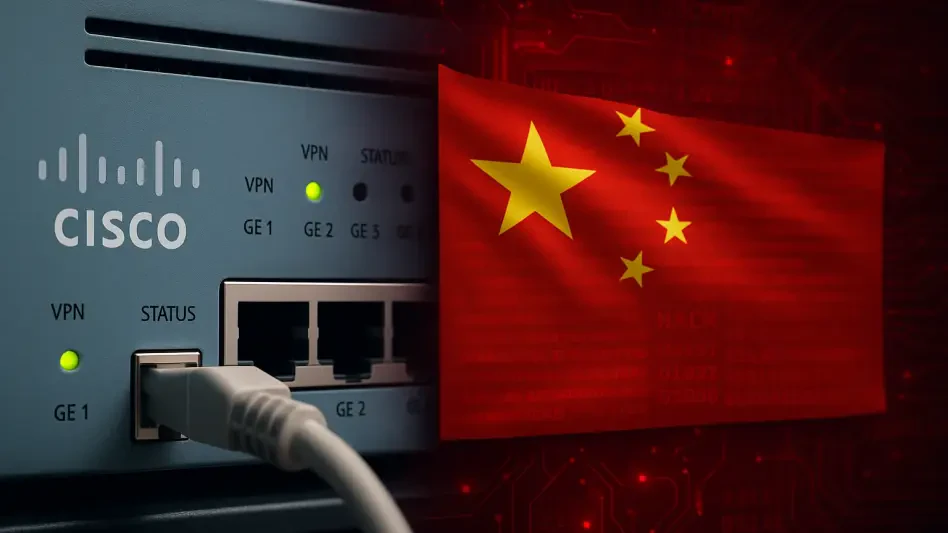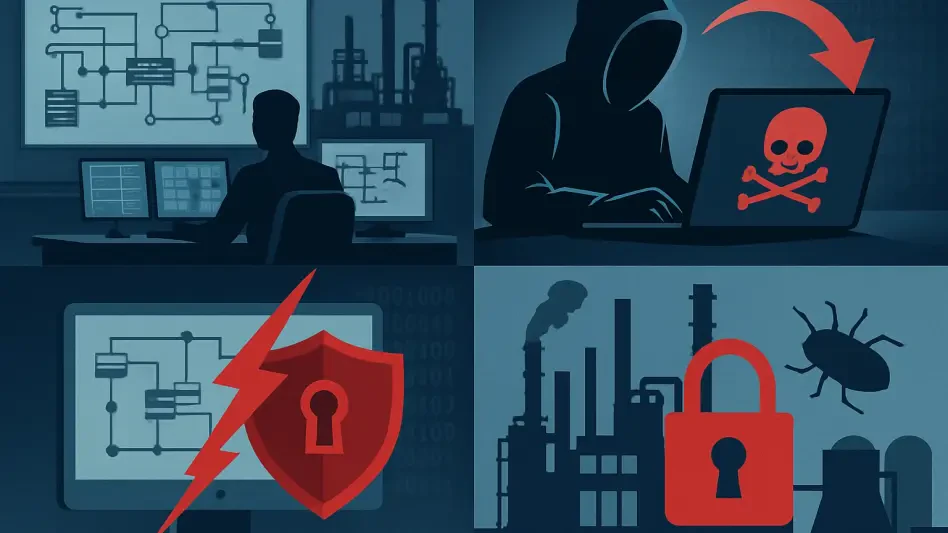In a digital era where every byte of data is a potential target, October 2025 revealed a chilling reality as a China-linked hacking group, known as Storm-1849 or ArcaneDoor, unleashed a sophisticated assault on Cisco Adaptive Security Appliance (ASA) firewalls. These devices, trusted by U.S. financial giants, defense contractors, and military entities to safeguard critical networks, became the epicenter of a cyber storm. What happens when the very tools meant to protect turn into gateways for espionage? This unfolding saga of relentless attacks exposes a stark vulnerability in global cybersecurity infrastructure.
The Gravity of a Hidden Threat
The significance of this breach cannot be overstated. Storm-1849’s campaign is not merely a technical exploit; it represents a calculated strike at the heart of national security and economic stability. With geopolitical tensions simmering, state-sponsored actors are increasingly weaponizing cyberspace to gain strategic advantages. Targeting Cisco ASA firewalls—a cornerstone of enterprise security—illustrates how a single point of failure can ripple across entire sectors. As reported by cybersecurity researchers, the group’s ability to exploit critical flaws despite public warnings signals an urgent need for robust, proactive defenses in an era of escalating cyber warfare.
The Anatomy of a Digital Invasion
Delving into the specifics, Storm-1849’s October 2025 campaign showcased chilling precision. The hackers exploited two severe vulnerabilities in Cisco ASA firewalls: a near-perfect 9.9-rated remote code execution flaw and a 6.5-rated privilege escalation bug. Even with a directive from the U.S. Cybersecurity and Infrastructure Security Agency (CISA) issued weeks prior to patch these weaknesses, many systems remained exposed. Researchers noted a peculiar pause in attacks during China’s Golden Week holiday in early October, suggesting a structured, possibly state-aligned operation with distinct working patterns.
Beyond timing, the tactics employed were alarmingly advanced. Zero-day exploits allowed the attackers to plant malware capable of enduring reboots and firmware updates, especially on outdated or end-of-support devices. This persistence turned compromised firewalls into backdoors for deep network infiltration, enabling credential theft and traffic interception. The focus on internet-exposed management interfaces highlighted a pervasive issue: legacy systems and delayed updates are Achilles’ heels in modern cybersecurity.
Voices from the Frontline
Cybersecurity experts have sounded the alarm on the sophistication of Storm-1849. John Carberry of Xcape, Inc., emphasized the group’s use of ROM-level malware, warning that unpatched systems must be considered breached by default. “These attackers aren’t just breaking in; they’re setting up permanent residence,” Carberry noted, underscoring the challenge of rooting out such deeply embedded threats. His insights point to a grim reality where traditional fixes fall short against adversaries with near-unlimited resources.
Jason Soroko of Sectigo added another layer of concern, focusing on the strategic value of ASA devices. “When a firewall centralizes so many security functions, a single compromise is catastrophic,” Soroko explained. He highlighted how attackers could pivot from a breached device to intercept sensitive data or move laterally across networks. This perspective reveals why these firewalls are prime targets for state-linked groups aiming to disrupt or spy on critical infrastructure.
James Maude of BeyondTrust brought urgency to the discussion, advocating for immediate action. “Organizations must patch now, per CISA’s mandate, and conduct thorough configuration reviews,” Maude urged. He suggested factory resets and credential updates for any suspected breaches, painting a picture of a battlefield where hesitation could mean total loss of control. Together, these expert voices weave a narrative of a formidable foe that demands an equally determined response.
Why Firewalls Became the Weakest Link
Cisco ASA firewalls, integral to network defense, manage access control and threat prevention for countless organizations worldwide. Their centrality makes them irresistible to attackers like Storm-1849, who exploit not just code vulnerabilities but also human and operational lapses. A breached firewall isn’t just a technical failure; it’s a skeleton key unlocking vast troves of sensitive information, from financial transactions to military communications.
The stakes are magnified by the sectors under siege. U.S. financial institutions, defense contractors, and military organizations rely on these devices to protect data tied to national interests. When vulnerabilities allow persistent access, the potential for espionage or sabotage skyrockets. This incident serves as a stark reminder that in the chess game of cyber warfare, critical infrastructure is often the first piece adversaries aim to capture.
Fortifying Defenses Against an Invisible Enemy
Countering threats like Storm-1849 demands a multi-pronged strategy tailored to the unique risks of Cisco ASA firewalls. First, immediate action is non-negotiable: organizations must apply patches as directed by CISA and conduct forensic analysis on potentially compromised systems. For those suspecting breaches, experts recommend factory resets coupled with updates to credentials and certificates to sever any lingering attacker access.
Operational hardening offers another layer of protection. Inventorying all ASA devices, updating to the latest supported software, and restricting management access with multi-factor authentication are critical steps. Segmenting the management plane on isolated networks further minimizes exposure. Regular credential rotation and forwarding logs to a Security Information and Event Management (SIEM) system for real-time monitoring can help detect anomalies like unexpected reboots or gaps in logging.
Long-term resilience requires a shift in mindset. Assuming breach as the default for unpatched or legacy systems pushes organizations to prioritize modernization and reduce internet-facing interfaces. Watching for subtle signs of compromise and maintaining vigilance through continuous monitoring are essential to staying ahead of persistent threats. These strategies, grounded in expert guidance, provide a blueprint for safeguarding against not just Storm-1849, but the next wave of cyber adversaries as well.
Reflecting on a Battle Fought
Looking back, the October 2025 assault by Storm-1849 on Cisco ASA firewalls stood as a defining moment in the ongoing struggle for digital security. It exposed how even the most trusted defenses could crumble under the weight of sophisticated, state-linked attacks. The pause during national holidays and the use of zero-day exploits painted a picture of an enemy both methodical and relentless.
Moving forward, organizations had to embrace a new reality where cyber threats were no longer occasional risks but constant pressures. Implementing layered defenses, from immediate patches to strategic overhauls, became the only path to resilience. Beyond technology, fostering a culture of urgency and preparedness emerged as vital, ensuring that the lessons of this siege shaped stronger protections for the future.








